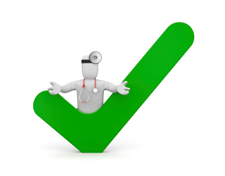
While e-commerce and online banking have given their respective industries a significant omnichannel boost, healthcare, especially on the provider side, has a steep hill to climb in order to deliver an omnichannel patient experience.

While e-commerce and online banking have given their respective industries a significant omnichannel boost, healthcare, especially on the provider side, has a steep hill to climb in order to deliver an omnichannel patient experience.
What is “omnichannel?”
First, let’s take a step back and define the buzzword. “Omnichannel” experience means delivering consistent, seamless interaction across all touchpoints – physical locations, phone, web/mobile, and social. In the world of retail, buying a product online and picking it up or returning it to your nearest store is considered a classic example.
Studies routinely show that 80% or more of patients begin their patient journey online in some form or another. As patients become increasingly consumerized, they will also bring their expectations of good buying experiences along with them.
So how can we capitalize on omnichannel thinking in healthcare?
Put all the “but” thinking aside and consider some more visionary examples:
- A patient browses for information about eczema on his provider’s website. He reads a few articles, then finds his doctor on the site, and clicks through to a patient portal to make or request an appointment. Perhaps he receives an appointment reminder the day before the appointment. In the office, he fills out some paperwork asking the reason for his visit. In the exam room, his doctor asks him the same questions. In today’s world, these are all discrete steps. In an omnichannel world, it’s a continuous flow. From the patient education pages on eczema, the site proactively asks him if he’d like to make an appointment. It then offers him a menu of your doctors to choose from. He chooses a doctor, and the site asks him: “May we share your browsing history on our site with your doctor?” He has the option of including any other questions for the doctor before his visit. When he submits his appointment request, he receives not only an email confirmation, but two or three recommended links of pages related to his browsing. At reception in the office, he checks in at a kiosk, using a scannable QR code that has been sent to his phone. When the doctor sees him, the doctor starts the conversation about eczema. In this scenario, the patient is better equipped with information about his condition, and not just satisfied but delighted with his experience in the office.
- A mother calls her group’s Pediatrics department to make an appointment for a “measles shot.” In today’s world, the appointment is scheduled, and she comes into the office with her child. End of story. In an omnichannel world, the conversation shifts. The patient scheduling rep says “I’ll be happy to help you. If you use our patient portal, you can get reminders for your children’s full immunization schedule, make appointments, and even print immunization records for school. May I walk you through that and get you set up right now?” Once she has signed up, she receives material showing the full immunization schedule to expand her literacy beyond a mere measles shot. In this scenario, the mother is now registered for the portal. She no longer has to remember critical dates for a well child. She understands immunizations better. And your practice adds yet another small victory in its quest for meaningful use.
- A patient spends time on your website. The good news is that it’s clean, well-designed, and easy to find information. In today’s world, s/he then comes into your facility or onto your campus, and the contrast is jarring. It’s a maze. Rooms are a hodgepodge of colors. Signage is scarce, dingy, and unappealing. Posters in hallways and waiting rooms look like they were put up in the 1990s. You’ve already set up the tone for a dissatisfactory experience. In an omnichannel world, the look and feel of your websites is harmonized with the look and feel of your physical sites. Patients can go online and get an easy map to where they need to be, or have it sent to their phone. Signage uses logos, colors, and fonts that are consistent with your site design. Posters and brochures match the crisp design of your web pages. In waiting areas and cafe spaces, kiosks or tablets allow users to browse for information about their health needs and their doctors before they are seen. You have beacon technology pushing information related to the specific department they are visiting. In this scenario, you’ve created a continuity of experience that not only engages, but immerses the patient.
- A patient with Type 2 diabetes has unexpectedly been struggling with managing his/her blood sugar levels in the past few days. S/he is confused. In today’s world, s/he makes an appointment, sees a doctor or nurse practitioner, and undergoes a wide range of tests that may not be necessary but are administered just in case. In an omnichannel world, s/he starts with a telehealth screening with a certified diabetes educator. In the consultation, it turns out s/he has been eating a lot of fried foods lately, increasing insulin resistance. They discus his/her blood sugar levels and determine an office visit is not needed. Instead, they schedule a follow up telehealth consultation with a diabetes nutritionist. Diet will also be a topic of his/her next regularly-schedule office visit. In this scenario, the patient is not consuming unnecessary care or resources, and understands unexpected implications of his/her chronic condition better to be able to manage them more effectively going forward.
From Scenario To Practice
These scenarios illustrate some of what is possible when adopting an omnichannel mindset. It’s easy to envision many more with some creative energy. The technology is there (in pieces), and even well-established.
But the barriers to implementation in healthcare are real. Process and culture are strikes against us. Integration and interoperability hold technologies back from their full potential. So, too, is regulation, both in actuality and in perceived interpretations. But that doesn’t mean we can’t strive to build an omnichannel world for patients. Barriers aside, we can think closely about the patient journey, about how it takes place from channel to channel, about when patients move from one channel to another, and about the small victories with big returns we can create when we make channel transitions that much smoother.
While retail and banking are ahead of us, we can also take heart. They, too, struggle with the nuts and bolts of implementing elements of an omnichannel strategy. And they, too, are just at the beginning of that evolution. We can certainly adapt what’s working for them, answer their omnichannel challenge, and use it to create richer, more robust, and more engaging patient experiences, before, during, and after the point of care. Omnichannel tactics will quickly become a key ingredient in better patient engagement.
The post The Healthcare Omnichannel Challenge appeared first on Syncresis.






